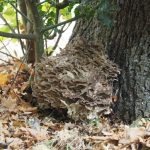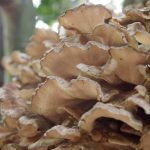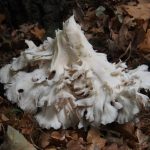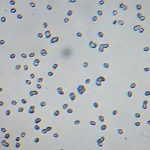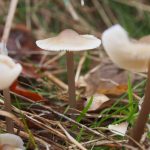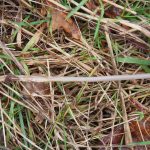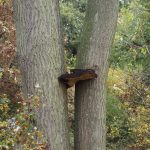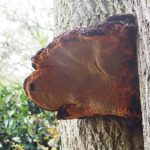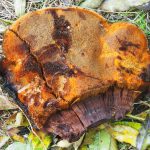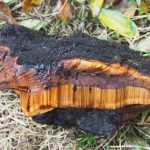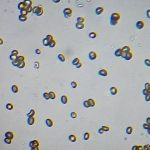1.
Butter Cap (
Collybia butyracea).
-
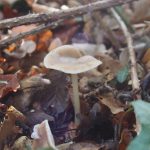
- 1. Butter Cap
-
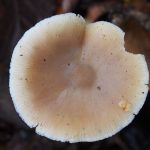
- 1. Butter Cap
-
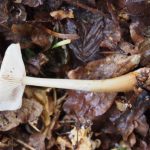
- 1. Butter Cap
-
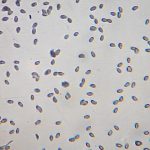
- 1. Butter Cap
Growing on leaf litter. A few scattered around. Cap 4-5cm, 7cm high. Slight mushroom smell. Sporeprint White. Spores 5.5-7.5µ x 3.5-4.5µ.
2.
Orange Slime Mould (
Species not identified).
-
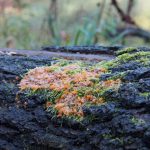
- 2. Orange Slime Mould
-
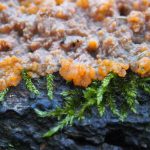
- 2. Orange Slime Mould
-
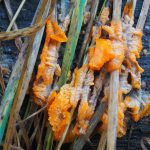
- 2. Orange Slime Mould
-
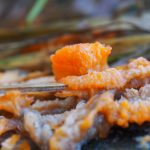
- 2. Orange Slime Mould
-
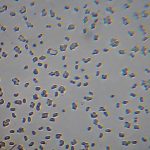
- 2. Orange Slime Mould
Growing on moss and dead grass leaves. Several patches, lumps, spots and blobs. Patches up to 15cm across. Little smell but maybe a slight rotten sweet smell. Can't match this with any fungus in my books but it does look like slime mould. There's several possible species but the ones I checked all have much larger spores. ID is possible. Spores 4.5-5.5µ x 2.5-3.5µ.
3.
Velvet Toughshank (
Kuehneromyces mutabilis).
-
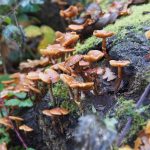
- 3. Velvet Toughshank
-
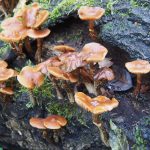
- 3. Velvet Toughshank
-
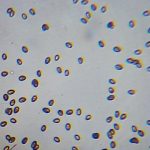
- 3. Velvet Toughshank
Growing on rotting oak log. Many clusters. Cap 2-4.5cm. Little smell. ID is almost sure. Sporeprint Reddish brown. Spores 7-9µ x 4.5-6.5µ.
4. Unidentified.
-
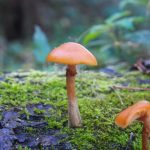
- 4. Unidentified
-
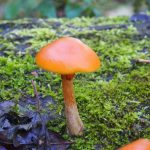
- 4. Unidentified
-
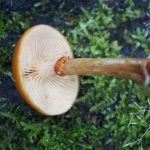
- 4. Unidentified
-
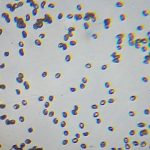
- 4. Unidentified
Growing on rotting oak log. A few scattered singly. Cap 3-4cm. Little smell. Sporeprint Reddish brown. Spores 5.5-8µ x 4.5-6.5µ.
5.
Mycena alcalina.
-
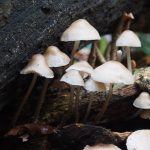
- 5. Mycena alcalina
-
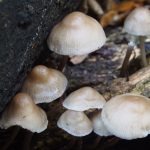
- 5. Mycena alcalina
-
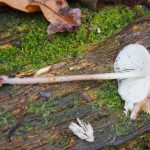
- 5. Mycena alcalina
-
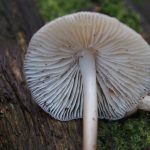
- 5. Mycena alcalina
-
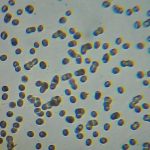
- 5. Mycena alcalina
Growing on rotting oak log. Several clusters. Cap up to 5cm. No smell. Tough stem. ID is very likely. Sporeprint White. Spores 6.5-9µ x 5.5-7.5µ.
6.
Common Inkcap (
Coprinus atramentarius).
-
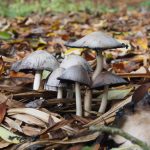
- 6. Common Inkcap
-
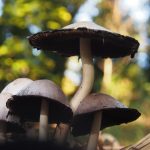
- 6. Common Inkcap
-
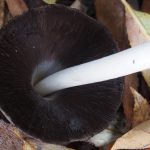
- 6. Common Inkcap
-
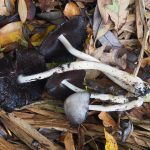
- 6. Common Inkcap
-
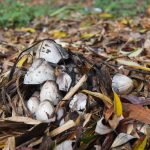
- 6. Common Inkcap
-
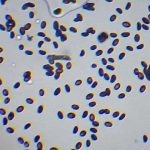
- 6. Common Inkcap
Growing from marshy soil. Pushing up through dead reeds. Some clusters. Cap up to 12cm when flat, stem up to 20cm. No smell. Strongly deliquesing. There's a lot of inkcap species but most of them are much smaller, so these can only really be Common Inkcaps. ID is very likely. Sporeprint Black. Spores 7.5-9.5µ x 4.5-6.5µ.
7.
Veiled Oyster (
Pleurotus dryinus).
-
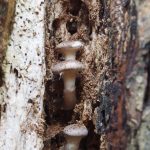
- 7. Veiled Oyster
-
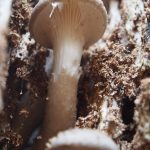
- 7. Veiled Oyster
-
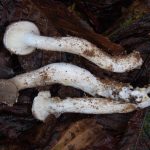
- 7. Veiled Oyster
-
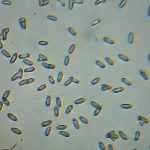
- 7. Veiled Oyster
Growing from crack in horse chestnut trunk. Group of 3. Cap 3cm, stem 10cm. Slight mushroom smell. Tough stem. These are very immature specimens. Sporeprint White. Spores 10.5-13.5µ x 5-6µ.
8.
Mycena flavescens.
-
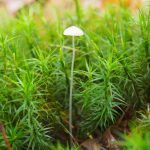
- 8. Mycena flavescens
-
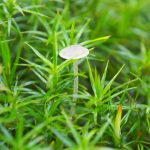
- 8. Mycena flavescens
-
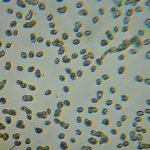
- 8. Mycena flavescens
Growing up through Haircap moss. A few dotted around. Cap 0.5-0.8cm, stem 8cm. ID is fairly likely. Sporeprint White. Spores 6.5-8µ x 4.5-6.5µ.
9.
Snowy Waxcap (
Hygrocybe virginea).
-
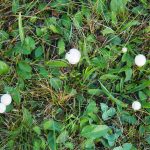
- 9. Snowy Waxcap
-
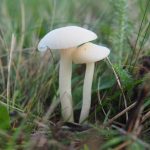
- 9. Snowy Waxcap
-
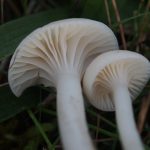
- 9. Snowy Waxcap
-
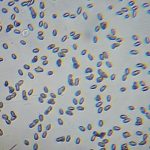
- 9. Snowy Waxcap
Growing in moss/grass. Three small groups. Cap up to 2.5cm, stem up to 7cm. No smell. Saw these in the same place last year. Sporeprint White. Spores 6.5-9µ x 4-5.5µ.
10.
Calocybe carnea.
-
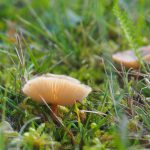
- 10. Calocybe carnea
-
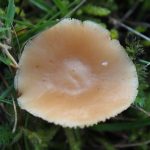
- 10. Calocybe carnea
-
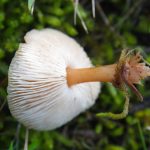
- 10. Calocybe carnea
-
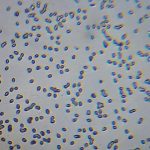
- 10. Calocybe carnea
Growing in moss/grass. Three. Cap 2-3cm. No smell. Growing close to ground. Difficult to identify small brown mushrooms. ID is wild guess. Sporeprint White. Spores 4-6µ x 3.5-4.5µ.
11.
False Chanterelle (
Hygrophoropsis aurantiaca).
-
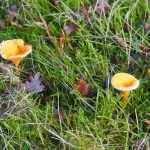
- 11. False Chanterelle
-
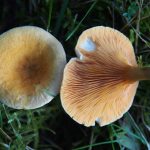
- 11. False Chanterelle
-
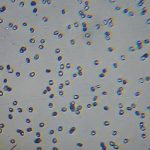
- 11. False Chanterelle
One growing beside pine. Others growing near gorse and hawthorn, with oak a bit further away, no pine. A few scattered around. Cap 3-4cm. No smell. I thought this only grew near pine, but apparently can also grow on alkaline sites in broad-leaved woods. Sporeprint White. Spores 5-7µ x 4-5.5µ.
12.
Beechwood Sickener (
Russula nobilis).
-
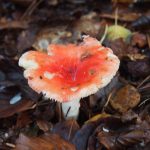
- 12. Beechwood Sickener
-
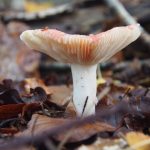
- 12. Beechwood Sickener
-

- 12. Beechwood Sickener
Growing next to birch but beeches also close by. A few scattered around. Cap 5-6cm, stem 4cm. No smell. Taste quite hot. Cap nearly 1/2 peeling. ID is fairly likely. Sporeprint White. Spores 6.5-8.5µ x 5-7µ.
13.
Fly Agaric (
Amanita muscaria).
-
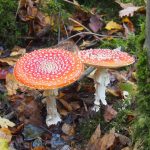
- 13. Fly Agaric
-
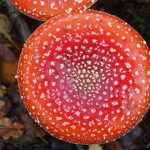
- 13. Fly Agaric
-
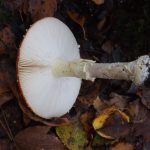
- 13. Fly Agaric
-
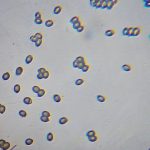
- 13. Fly Agaric
Near various trees, about 5m from surrounding birch trees. Two together. Cap 10cm, stem 10cm. No smell. Sporeprint White. Spores 8.5-10.5µ x 6-8µ.





















































